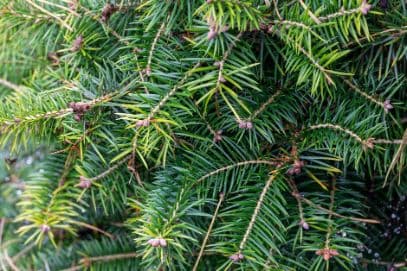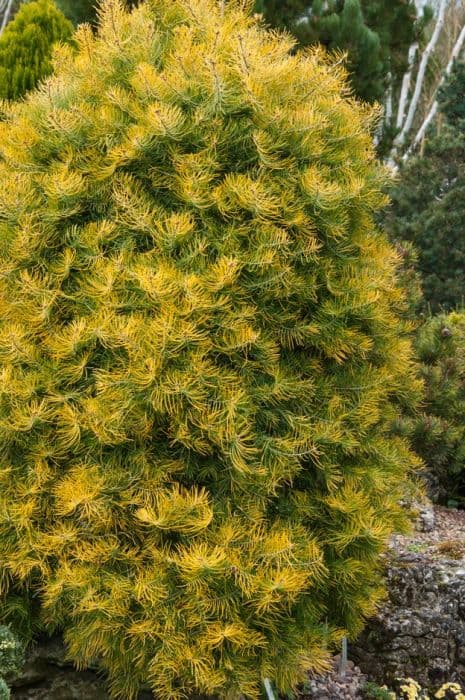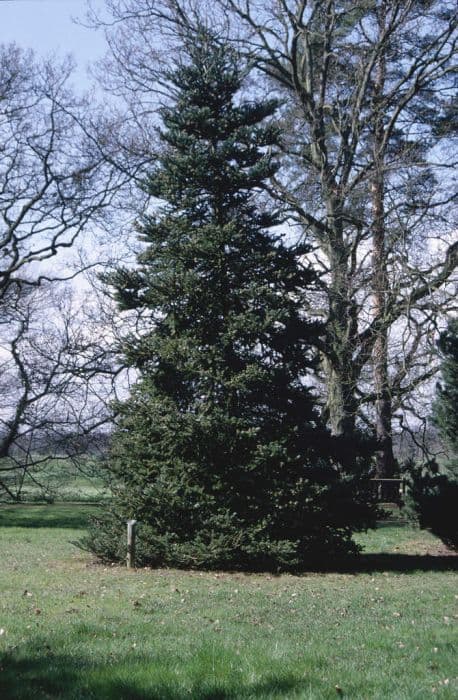Norway Spruce Picea abies 'Clanbrassiliana'

ABOUT
The 'Clanbrassiliana' is a cultivar of Norway spruce known for its distinctive appearance. This plant has a dense, bushy growth habit, presenting with a rich green color that's typical of many evergreen conifers. The needles have a glossy appearance and are quite short, contributing to the overall compact look of the foliage. The plant's branches tend to grow horizontally out from the central trunk, creating a somewhat tiered effect. This horizontal branching also gives it a full-bodied look, even without specifying its actual dimensions. Newer growth can sometimes have a slightly brighter green color compared to the more mature, darker green needles further back. Throughout the year, the Norway spruce maintains its needle foliage, offering a constant display of greenery. It bears the characteristic cone-shaped silhouette that is often associated with spruce trees, even though this particular cultivar may have a more rounded or squat shape owing to its specific growth tendencies. In terms of reproductive features, the 'Clanbrassiliana' produces cones as well, although they may be less prominent or numerous compared to larger, full-sized trees. These cones typically hang down from the branches and have a woody texture, starting out with a more subtle color and aging into a classic brown as they mature and dry out. Overall, the 'Clanbrassiliana' is appreciated for its evergreen nature, providing year-round visual interest with its lush green, compact, and full needle foliage. It is a decorative element in any garden space, valued for its timeless and classic coniferous appearance.
About this plant
 Names
NamesFamily
Pinaceae
Synonyms
Clanbrassiliana Spruce, Dwarf Norway Spruce
Common names
Picea excelsa 'Clanbrassiliana', Picea abies 'Clanbrassiliana'
 Toxicity
ToxicityTo humans
Norway spruce is the most common common name for Picea abies 'Clanbrassiliana'. Generally, the Norway spruce is not considered poisonous to humans. Ingesting parts of this plant typically does not result in toxic symptoms. However, as with any plant material, ingestion in large quantities might cause mild stomach upset due to the indigestible fibers or natural plant compounds.
To pets
Norway spruce is the most common common name for Picea abies 'Clanbrassiliana'. This plant is generally considered non-toxic to pets. The ingestion of Norway spruce parts is not known to cause poisoning in pets. Nevertheless, it could possibly cause minor gastrointestinal upset if your pet consumes large amounts of the plant material, such as the needles or bark, which can be difficult to digest.
 Characteristics
CharacteristicsLife cycle
Perennials
Foliage type
Evergreen
Color of leaves
Green
Height
3 feet (0.91 meters)
Spread
3 feet (0.91 meters)
Plant type
Tree
Hardiness zones
3
Native area
Europe
Benefits
 General Benefits
General Benefits- Aesthetic Appeal: Picea abies 'Clanbrassiliana', commonly known as Norway spruce, adds visual interest to landscapes with its unique form and dense foliage.
- Erosion Control: The root system of this plant helps to stabilize soil and prevent erosion on slopes.
- Habitat for Wildlife: Provides shelter and nesting sites for birds and other wildlife.
- Shade: Offers shade in gardens and parks, creating a cooler microclimate during hot months.
- Privacy Screen: When planted in rows, it serves as an effective visual barrier for privacy.
- Windbreak: Acts as a windbreak, offering protection against strong winds for other plants and structures.
- Durability: The plant is hardy and resilient to cold climates, making it suitable for northern landscapes.
- Christmas Decor: Widely used as a Christmas tree due to its symmetrical shape and evergreen foliage.
 Medical Properties
Medical PropertiesThis plant is not used for medical purposes.
 Air-purifying Qualities
Air-purifying QualitiesThis plant is not specifically known for air purifying qualities.
 Other Uses
Other Uses- Woodworking: The durable wood of the Norway spruce is suitable for creating musical instruments such as violins, harps, and guitars.
- Windbreaks: Due to its density and growth habit, the Norway spruce can be planted in rows to protect against wind erosion in agricultural areas.
- Wildlife habitat: The dense foliage provides shelter and nesting sites for various bird species and small mammals.
- Christmas traditions: The Norway spruce is commonly used as a Christmas tree in many households across Europe and North America due to its symmetrical shape and evergreen nature.
- Cultural symbol: In some cultures, the Norway spruce is a symbol of resilience and is planted to commemorate significant events and anniversaries.
- Erosion control: Its robust root system helps stabilize soil on slopes, minimizing the risk of landslides in hilly terrains.
- Noise barriers: When planted in dense rows, Norway spruce can act as a natural sound barrier, making it useful for planting along highways or around airports.
- Shade provider: The trees can offer a cool, shaded area in gardens and parks, creating a comfortable outdoor environment during warmer months.
- Privacy screens: The thick growth of Norway spruce can be used to create natural privacy screens between properties or to conceal unsightly areas.
- Mast production: The spruce produces cones that serve as a source of food for wildlife, particularly in winter when other food sources are scarce.
Interesting Facts
 Feng Shui
Feng ShuiThe Norway spruce is not used in Feng Shui practice.
 Zodiac Sign Compitability
Zodiac Sign CompitabilityThe Norway spruce is not used in astrology practice.
 Plant Symbolism
Plant Symbolism- Longevity and Endurance: As a variety of the Norway spruce, Picea abies 'Clanbrassiliana' symbolizes long life and resilience. These trees can live for several hundreds of years, representing the ability to withstand the tests of time.
- Growth and Stability: This plant is symbolic of robust growth and foundational stability. The spruce tree grows straight and tall, rendering it a symbol for reaching one's potential while staying grounded.
- Protection: The spruce has been traditionally used to make protective charms. The branches and needles are believed to ward off evil spirits, symbolizing safety and security.
- Renewal and Purity: The evergreen nature of the Norway spruce signifies continual renewal and a representation of purity. Its ability to stay green throughout the year is seen as a sign of unwavering vitality.
- Peace and Harmony: The evergreen branches are often associated with peace and harmony, especially during festive seasons like Christmas when spruce trees are used as Christmas trees, encouraging a spirit of togetherness.
 Water
WaterThe Norway Spruce (Picea abies 'Clanbrassiliana') requires consistent moisture, especially during dry periods. It's important to water deeply and thoroughly to ensure water reaches the deep roots. Water the tree once a week with about 10 gallons during its growing season in spring and summer, while adjusting the amount for rainfall. During the dormant season in fall and winter, reduce the frequency to every two weeks or based on soil moisture. Ensure that the soil is well-draining to prevent waterlogged conditions which can lead to root rot.
 Light
LightThe Norway Spruce prefers full sun to part shade. An ideal spot would be one that receives at least four to six hours of direct sunlight every day. The plant can tolerate partial shade, but for optimal growth and health, the more sun the better. Avoid locations that are constantly shaded or have high competition for light.
 Temperature
TemperatureNorway Spruce thrives across a broad temperature range, tolerating a minimum temperature of around -50°F and a maximum temperature of about 90°F. The ideal temperature for robust growth is between 60°F and 75°F. This plant is well-suited for cold climates and can withstand significant winter chill.
 Pruning
PruningNorway Spruce trees require minimal pruning, mostly for dead or broken branches or to maintain shape. It is best to prune in late winter or early spring before new growth starts. Periodic thinning of the branches will help light penetrate the canopy, which can promote better growth.
 Cleaning
CleaningNot needed
 Soil
SoilThe Norway spruce 'Clanbrassiliana' thrives in well-drained, sandy loam soil with a slightly acidic to neutral pH between 6.0 and 7.0. A mix of two parts loam, one part peat moss, and one part sand or perlite ensures good drainage and aeration.
 Repotting
RepottingNorway spruce 'Clanbrassiliana' typically does not need frequent repotting. It should be repotted every 3 to 5 years to prevent root-bound conditions and to refresh the soil.
 Humidity & Misting
Humidity & MistingNorway spruce 'Clanbrassiliana' prefers moderate humidity levels but is tolerant of a wide range of conditions. As a conifer, it does not require high humidity environments typical of tropical plants.
 Suitable locations
Suitable locationsIndoor
Ensure bright light, cool temperatures, and air circulation.
Outdoor
Provide full sun, cool climate, and well-drained soil.
Hardiness zone
3-7 USDA
 Life cycle
Life cyclePicea abies 'Clanbrassiliana', commonly known as the Norway spruce 'Clanbrassiliana', begins life as a seed, typically germinating in the spring when soil temperatures are favourable. The seedling grows into a juvenile tree, establishing a root system and a strong stem, while the characteristic conical shape starts to develop. Over several years, it enters a mature phase, characterized by a significant increase in height and girth and beginning to produce cones after 10-40 years. The mature tree stage can last for well over a century, during which it reaches its full size, continues annual growth, and produces numerous cones filled with seeds. In the reproductive stage, the cones disperse seeds, which can lead to the establishment of new seedlings in suitable conditions, perpetuating the species' life cycle. Finally, after potentially hundreds of years, the Norway spruce 'Clanbrassiliana' reaches its senescence and decline phase, leading to the end of its lifecycle.
 Propogation
PropogationPropogation time
Early Spring
Picea abies 'Clanbrassiliana', commonly known as the Norway Spruce 'Clanbrassiliana', is typically propagated using semi-hardwood cuttings. This method is favored as it maintains the genetic fidelity of the cultivar. To propagate, select healthy, semi-hardwood shoot tips of 4 to 6 inches (approximately 10 to 15 centimeters) in length from a parent plant during the late summer. The cuttings should be taken with a sharp, clean pair of pruning shears, and the lower needles should be stripped to expose the nodes. Dipping the cut end into a rooting hormone can encourage root development. The prepared cuttings should then be inserted into a well-draining rooting medium and kept under high humidity and indirect light until roots have established, which can take several weeks to months.









